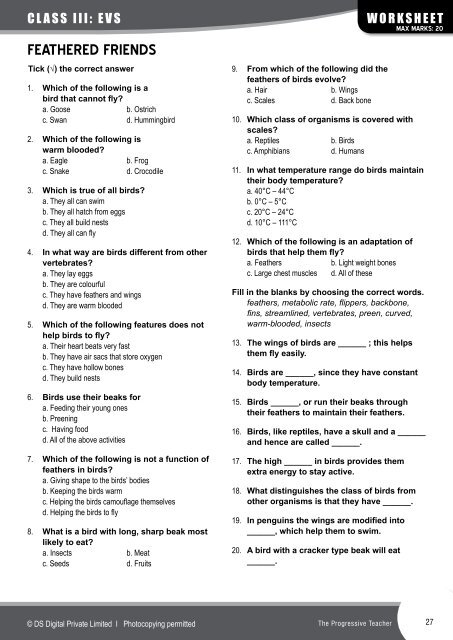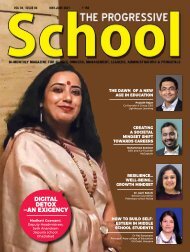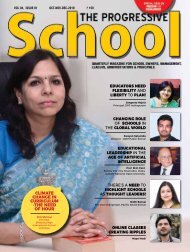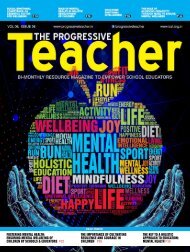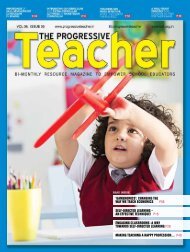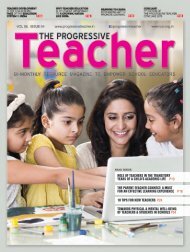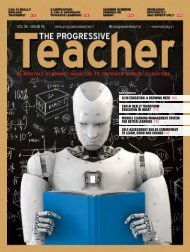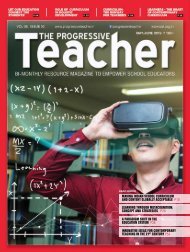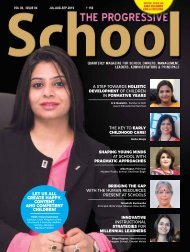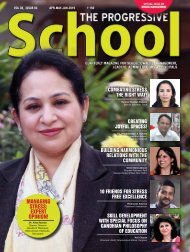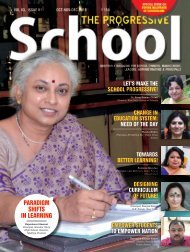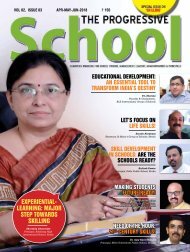The Progressive Teacher Vol 04 Issue 04
This issue of The Progressive Teacher focuses on "New Instructional Tools ". In this edition, articles explore the changes brought by technological advancements in the tools of educational instruction. Enjoy reading!
This issue of The Progressive Teacher focuses on "New Instructional Tools ". In this edition, articles explore the changes brought by technological advancements in the tools of educational instruction. Enjoy reading!
You also want an ePaper? Increase the reach of your titles
YUMPU automatically turns print PDFs into web optimized ePapers that Google loves.
Class III: EVS<br />
Feathered friends<br />
Tick (√) the correct answer<br />
1. Which of the following is a<br />
bird that cannot fly?<br />
a. Goose b. Ostrich<br />
c. Swan d. Hummingbird<br />
2. Which of the following is<br />
warm blooded?<br />
a. Eagle b. Frog<br />
c. Snake d. Crocodile<br />
3. Which is true of all birds?<br />
a. <strong>The</strong>y all can swim<br />
b. <strong>The</strong>y all hatch from eggs<br />
c. <strong>The</strong>y all build nests<br />
d. <strong>The</strong>y all can fly<br />
4. In what way are birds different from other<br />
vertebrates?<br />
a. <strong>The</strong>y lay eggs<br />
b. <strong>The</strong>y are colourful<br />
c. <strong>The</strong>y have feathers and wings<br />
d. <strong>The</strong>y are warm blooded<br />
5. Which of the following features does not<br />
help birds to fly?<br />
a. <strong>The</strong>ir heart beats very fast<br />
b. <strong>The</strong>y have air sacs that store oxygen<br />
c. <strong>The</strong>y have hollow bones<br />
d. <strong>The</strong>y build nests<br />
6. Birds use their beaks for<br />
a. Feeding their young ones<br />
b. Preening<br />
c. Having food<br />
d. All of the above activities<br />
7. Which of the following is not a function of<br />
feathers in birds?<br />
a. Giving shape to the birds’ bodies<br />
b. Keeping the birds warm<br />
c. Helping the birds camouflage themselves<br />
d. Helping the birds to fly<br />
8. What is a bird with long, sharp beak most<br />
likely to eat?<br />
a. Insects b. Meat<br />
c. Seeds d. Fruits<br />
9. From which of the following did the<br />
feathers of birds evolve?<br />
a. Hair b. Wings<br />
c. Scales d. Back bone<br />
worksheet<br />
10. Which class of organisms is covered with<br />
scales?<br />
a. Reptiles b. Birds<br />
c. Amphibians d. Humans<br />
Max Marks: 20<br />
11. In what temperature range do birds maintain<br />
their body temperature?<br />
a. 40°C – 44°C<br />
b. 0°C – 5°C<br />
c. 20°C – 24°C<br />
d. 10°C – 111°C<br />
12. Which of the following is an adaptation of<br />
birds that help them fly?<br />
a. Feathers b. Light weight bones<br />
c. Large chest muscles d. All of these<br />
Fill in the blanks by choosing the correct words.<br />
feathers, metabolic rate, flippers, backbone,<br />
fins, streamlined, vertebrates, preen, curved,<br />
warm-blooded, insects<br />
13. <strong>The</strong> wings of birds are ______ ; this helps<br />
them fly easily.<br />
14. Birds are ______, since they have constant<br />
body temperature.<br />
15. Birds ______, or run their beaks through<br />
their feathers to maintain their feathers.<br />
16. Birds, like reptiles, have a skull and a ______<br />
and hence are called ______.<br />
17. <strong>The</strong> high ______ in birds provides them<br />
extra energy to stay active.<br />
18. What distinguishes the class of birds from<br />
other organisms is that they have ______.<br />
19. In penguins the wings are modified into<br />
______, which help them to swim.<br />
20. A bird with a cracker type beak will eat<br />
______.<br />
© DS Digital Private Limited I Photocopying permitted <strong>The</strong> <strong>Progressive</strong> <strong>Teacher</strong><br />
27


